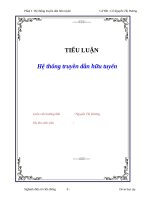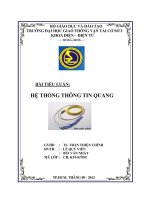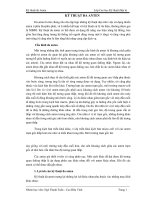Tiểu luận Hệ thống thông tin quang HFA
Bạn đang xem bản rút gọn của tài liệu. Xem và tải ngay bản đầy đủ của tài liệu tại đây (569.72 KB, 22 trang )
VISIBLE LIGHT COMMUNICAITION
Enhancing Optical Signal-to-Noise Ratio in Terrestrial Cascaded EDFAs Fiber
Optic Communication Links using Hybrid Fiber Amplifier
Outline
1. Abstract of the paper
2. Introduction
3. Calculating models
4. Buiding algorithm charts
5. Numerical Results and analysis
6. Conclusion
Abstract of the paper
Calculating models of Terrestrial DWDM cascaded EDFAs Fiber Optic Communication Links using Hybird
Fiber Amplifier (HFA)
Build algorithm charts
Algorithm-based numerical calculating (MathCAD program) is applied in typical system
Optimized results show that the OSNR can be increased by (1-5)dB
INTRODUCTION
•
•
Hybrid Fiber Amplifier (HFA) is combination of Distributed Raman Amplifier (DRA) and EDFA
Many WDM cascaded EDFAs systems using HFA have been investigated, experimented and deployed in
order to get better OSNR
CALCULATING MODELS
•
Calculating model consisting only one HFA if distance of Terrestrial WDM cascaded EDFAs Fiber Optic
Comminication Link is shorter than 1,000km
•
Three typical calculating models are given in which HFAs are located in the first span, middle span and last
span respectively
CALCULATING MODELS
CALCULATING MODELS
•
Calculating model of HFA with Backward pump at 1450nm
•
Optical Signal-to-Noise Ratio (OSNR) at the end of transmission link
CALCULATING MODELS
•
Signal power at the end of link
•
FWM noise at the end of link
•
Accumulated ASE noise at the end of link
BUIDING ALGORITHM CHARTS
•
Algorithm chart for calculating FWM noise power
BUIDING ALGORITHM CHARTS
•
Algorithm chart for calculating ASE noise power
BUIDING ALGORITHM CHARTS
•
Main algorithm chart for optimizing OSNR
BUIDING ALGORITHM CHARTS
•
•
Applying in the Vietnam Nation-wide DWDM system for optimization OSNR
Vinh-Danang segment with HFA located in the first span; Optimized values: G1, G2 … G6,;Pin/ch ;
OSNR are presented in Italic and Bold styles
NUMERICAL RESULTS AND ANALYSIS
•
Choose 4 wavelengths in this calculation are similar to that in realistic link
•
Non-Optimized and Optimized Gain of EDFAs in Vinh-Danang Link
NUMERICAL RESULTS AND ANALYSIS
•
Signal and different noise powers at the end of 4-channel Vinh-Danang Link in cases of optimized and
non-optimized parameters
NUMERICAL RESULTS AND ANALYSIS
•
Non-Optimized OSNR at the end of Vinh-Danang link
NUMERICAL RESULTS AND ANALYSIS
•
Non-Optimized OSNR (measured realistic results) and Optimized OSNR at the end of Vinh-Danang Link
(MathCAD program)
NUMERICAL RESULTS AND ANALYSIS
•
Signal and different noise powers at the end of 16-channel Vinh-Danang Link in cases of optimized and
non-optimized parameters
NUMERICAL RESULTS AND ANALYSIS
•
Optimized OSNR versus ordinal number of channels at the end of 16-channel Vinh-Danang Link
NUMERICAL RESULTS AND ANALYSIS
•
Signal and different noise powers at the end of 32-channel Vinh-Danang Link in cases of optimized and
non-optimized parameters
NUMERICAL RESULTS AND ANALYSIS
•
Optimized OSNR versus ordinal number of channels at the end of 32-channel Vinh-Danang Link
CONCLUSION
•
We proposed three calculating models of Terrestrial cascaded EDFAs Fiber Optic Communication Links
using HFA
•
We built then algorithm charts for calculating FWM noise power, accumulated ASE noise power and for
optimizing OSNR at the end of link in general case
•
Numerical calculating was applied in typical system (WDM Nation-wide Links in Vietnam) to get higher
OSNR by (1-5)dB comparing with that in cases of parameters chosen by experience way
Thank you









